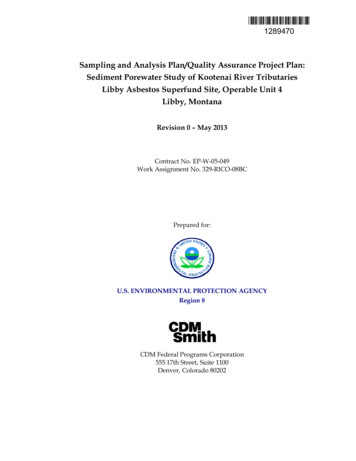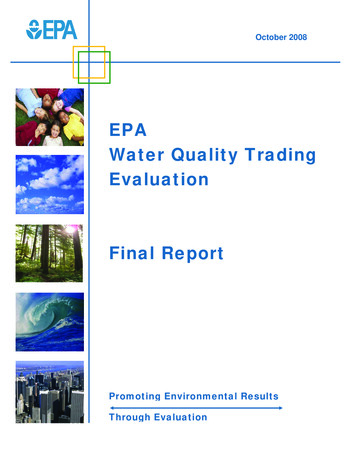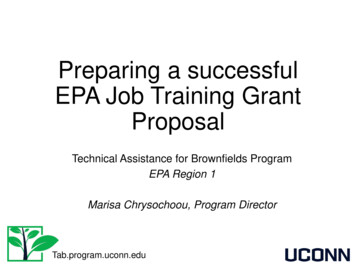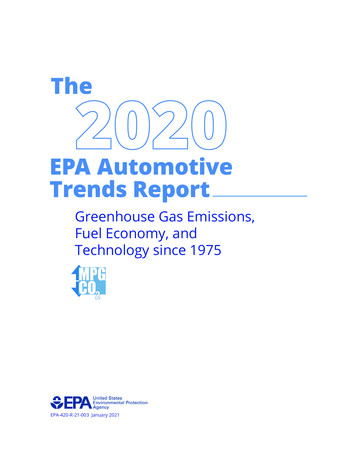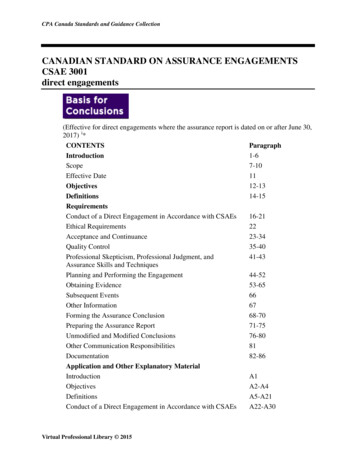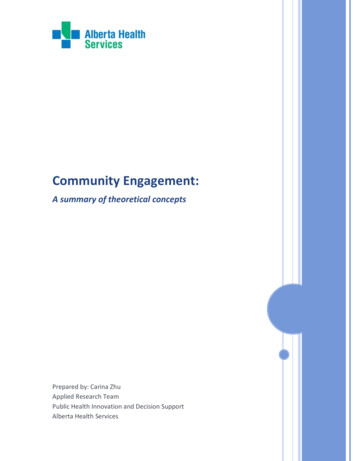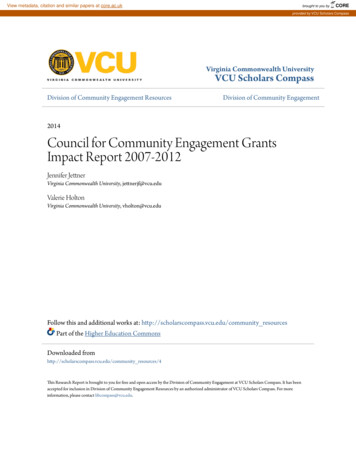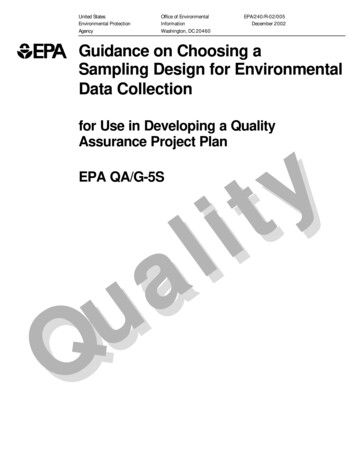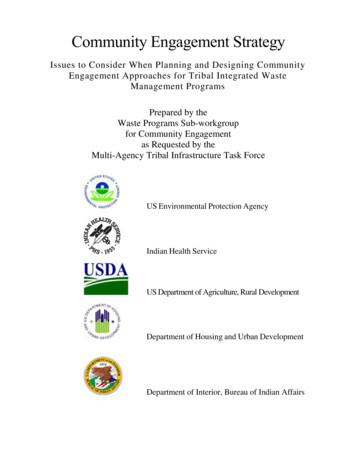
Transcription
Community Engagement StrategyIssues to Consider When Planning and Designing CommunityEngagement Approaches for Tribal Integrated WasteManagement ProgramsPrepared by theWaste Programs Sub-workgroupfor Community Engagementas Requested by theMulti-Agency Tribal Infrastructure Task ForceUS Environmental Protection AgencyIndian Health ServiceUS Department of Agriculture, Rural DevelopmentDepartment of Housing and Urban DevelopmentDepartment of Interior, Bureau of Indian Affairs
COMMUNITY ENGAGEMENTSTRATEGYIssues to Consider When Planning and Designing Community EngagementApproaches for Tribal Integrated Waste Management ProgramsITF Waste Workgroup #2- Final1
ContentsExecutive Summary/Background . 41Introduction . 51.1What is Community Engagement? . 51.2Why Community Engagement Matters to Tribal Communities Developing Integrated WasteManagement Programs . 51.3Principles and Core Values for Effective Community Engagement . 52 How to Use the ITF Community Engagement Strategies to Provide Outreach to Tribal Communitieson the Importance of Integrated Waste Management Programs . 62.1Purpose of the Strategy . 62.2Intended Users . 62.3Partner with Existing Initiatives . 62.4Identifying Challenges/Barriers. 73Reaching All Sectors of the Community . 74Engagement Techniques and Methods . 954.1Displays – Leaflets/Posters/Signs. 104.2Newsletter/Tribal Newspaper/Tribal Magazines . 114.3Hotline or 1-800 Number . 114.4Web-based Announcements/Social Media (Electronic Media) . 114.5Public Exhibits . 124.6Surveys and Questionnaires . 124.7Public Meetings. 134.8Interviews. 134.9Open Day or “Drop-in” Sessions . 144.10Community Fairs/Events (Earth Day, Community Cleanup Day, etc.) . 144.11School Visits . 154.12Workshop . 154.13Waste Audits . 154.14Tribal Community-Based Social Marketing . 164.15Focus Groups. 17Community Engagement Steps . 175.1Step 1 – Determine the Need for Community Engagement . 185.2Step 2 – Develop a Tribal Waste Management Advisory Committee. 185.3Step 3 – Define the Project Scope, Goals, and Anticipated Outcomes. 192
65.4Step 4 – Identify and Analyze the Stakeholders/Community Served . 215.5Step 5 - Consider Engagement Techniques / Methods and Develop Engagement Strategies . 225.6Step 6 – Create and Implement an Operational Plan . 225.7Step 7 – Monitor Progress, Evaluate the Plan, and Improve/Modify Plan (If Needed) . 23Resources and Templates . 256.1Community-Based Social Marketing (CBSM) Project – EPA Region 5. 256.2Tribal Waste Management Program Sustainability Evaluation Tool . 256.3Tribal Solid Waste Advisory Network (TSWAN) – . 266.4Integrated Waste Management Plan Template . 266.5Leaflets/Posters/Signs Resources . 266.6Newsletter Article Template . 276.7Sample Social Media Posts (Web-based Announcement) . 276.8Sample Public Service Announcement (PSA) . 276.9Sample Surveys and Questionnaires Template . 276.10Public Meeting Resources . 286.11Sample Interview Questions . 286.12Open Day and/or “Drop-in” Sessions Examples . 286.13Community Fairs / Events Examples . 286.14Community Outreach Material . 296.15EPA Public Participation Guide . 296.16 EPA’s Office of Land and Emergency Management (OLEM) Communications Strategies Tool –Community Outreach. 296.17 Tribal Solid Waste Advisory Network - Tribal Strategic Planning for EnvironmentalManagement Sustainability Template . 296.18National Tribal Waste Management Peer Matching Program . 30Appendix A . 31Tribal Solid Waste Advisory Network (TSWAN) . 31Integrated Waste Management Plan Information Checklist . 313
Executive Summary/BackgroundThe Infrastructure Task Force (ITF) Waste Programs Sub-workgroup Community Engagement Strategyprovides guidance on the issues to consider when planning and designing community engagementapproaches for tribal integrated waste management programs. It focuses on quality and effectiveness,process and community engagement planning, designing engagement tailored to tribal integrated wastemanagement and the range of stakeholders affected.Specifically, the goal of each section in the strategy is:1. Introduction – Provides a comprehensive explanation of the principles and core values that guidecommunity engagement.2. How to Use the ITF Community Engagement Strategy – Details the purpose and intended use ofthis document.3. Researching All Sectors of the Community – Outlines how to identify and analyze the communityand stakeholders affected by the issue/project.4. Engagement Techniques and Methods – Presents and describes different levels and types ofcommunity engagement approaches.5. Community Engagement Steps – Provides step-by-step guidelines for developing a communityengagement plan.Step 1: Determine the Need for Community EngagementStep 2: Develop a Tribal Waste Management Advisory CommitteeStep 3: Define the Project Scope, Goals, and Anticipated OutcomesStep 4: Identify and Analyze Stakeholders/Community ServedStep 5: Consider Engagement Techniques/MethodsStep 6: Create and Implement an Implementation/Operational PlanStep 7: Monitor Progress, Evaluate the Plan, Modify (if needed)6. Resources and Templates – Provides examples, resources, and templates to assist tribesthroughout the development and implementation of the community engagement process.4
1 Introduction1.1 What is Community Engagement?Community engagement is the process of building relationships with tribal members,stakeholders, citizens and interest groups to work side-by-side as long-term partners—building acoalition of support on a range of integrated waste management policies, programs and serviceissues—with the end goal of protecting the environment and making the community a betterplace to live. It encompasses a wide variety of government–community interactions ranging frominformation sharing to community consultation and, in some instances, active participation ingovernment decision-making processes. Engagement can be formal or informal, direct or indirect.Effective community engagement allows the government to tap into diverse waste managementperspectives to improve the quality of its decisions. It enables citizens and communities to betterunderstand the processes of the government and builds their capacity to participate indeliberative processes by gaining confidence, skills, knowledge and experience.Community EngagementTo better involve the tribal community to achieve long-term and sustainable outcomes,processes, relationships, decision-making, and implementation of sustainable integrated wastemanagement programs.1.2 Why Community Engagement Matters to Tribal CommunitiesDeveloping Integrated Waste Management ProgramsIt is difficult to create and implement an integrated waste management program or projectwithout outside assistance and support. Through community engagement, tribal members play ameaningful role in the deliberations, discussions, decisions and/or implementation of integratedwaste management projects and programs affecting them. It empowers those from thecommunity to learn about in-depth waste management issues, allowing them to see multiplesides and increasing the likelihood that projects and/or solutions will be widely accepted.Community engagement allows organizational and government leaders to take on roles asfacilitators, supporters, and collaborators—offering them enhanced perspectives while giving astronger voice to tribal citizens and stakeholders. Drawing on local knowledge from diversegroups creates solutions that are both practical and effective. Moreover, community engagementincreases the level of trust between tribal communities and local and federal governments andbridges the gap by connecting people who are not currently part of the direct constituency.Effective community engagement sometimes requires letting go of some of the traditional reinsof power and trusting that citizens can and will effectively engage in integrated wastemanagement issues. The result is a building and strengthening of partnerships that is healthy fora community and can more effectively address issues facing the community. Communityengagement increases the influence and ability to achieve desired changes for the community innearly any scenario, including the implementation of waste management programs.1.3 Principles and Core Values for Effective Community EngagementAn effective integrated waste management system engages communities as partners and buildsthe capacity of communities to foster a safer and cleaner environment. Recognizing citizens asthe community's most valuable resource, unleashes creativity and acknowledges collaborationas the primary catalyst to move the community forward.5
The approach to community engagement is guided by the following principles: Integrity: Community engagement should be transparent and clear in scope and purpose. Inclusiveness: Community engagement should be accessible and balanced and capture afull range of values and perspectives. Dialogue: Community engagement should promote dialogue and open genuine discussion.It should be supported by timely and accurate information, be used to weigh options, anddevelop common understandings. Influence: Community engagement should be reflected in outcomes. The communityshould be able to see and understand the impact of their involvement.2 How to Use the ITF Community Engagement Strategies to ProvideOutreach to Tribal Communities on the Importance of IntegratedWaste Management ProgramsThis strategy provides recommendations and guidance for tribal integrated waste managementprograms in the design and implementation of a community engagement process. Most of the toolsoutlined in this strategy are presented in a way that speaks to tribal planning processes; however,the tools themselves can be used in a wide variety of contexts.2.1 Purpose of the StrategyThis strategy will help the reader understand the importance of reaching all sectors of thecommunity (Section 3), as well as levels and types of engagement methods and techniques(Section 4); and will outline the steps for effective community engagement (Section 5) based onintegrated waste management. Templates and resources (Section 6) are also provided to helpreaders develop a community engagement plan.Section 5 (Community Engagement Steps) of this strategy provides key steps for developing acommunity engagement blueprint. The strategy considers desired results for integrated wastemanagement programs and identifies key actions and required roles. In addition, templates andother resources are provided to assist in determining next steps and evaluating success. 2.2 Intended UsersThis strategy was designed for tribal governments—including tribal environmental departments,integrated waste management departments, waste advisory committees, etc.—interested indesigning and implementing a community engagement process that is inclusive, influential, andresults-oriented.This strategy is also aimed at federal, state, and local governments; nongovernmentalorganizations (NGOs); empowerment champions, practitioners, and council members tasked withdeveloping a comprehensive engagement strategy; and anyone with an interest in communityengagement. Government agencies and NGOs can use this strategy as a vehicle to build moreresilient relationships with the community and identify mechanisms for building a community’sstrength to address integrated waste management issues.2.3 Partner with Existing InitiativesIn many cases, community engagement strategies are executed through a partnership orcollaboration with existing organizations or initiatives. Building on existing networks or6
introducing an integrated waste management perspective provides opportunities for dialogueacross communities and various interested parties. Examples of planning initiatives that couldprovide opportunities for waste management dialogue include Integrated Resource ManagementPlans, Hazardous Waste Plans, Climate Change Adaptation Plans, economic development, andhousing development. Learn to recognize the synergies between the different sectors and thinkcarefully about whom to involve, when, and how.Potential Existing Networks to Engage Traditional and cultural structuresGovernment structureSchools and youth programsSports teams and leaguesChurches and faith-based organizationsIn addition, tapping into the cultural importance by including cultural history builds support andcredibility within the community.2.4 Identifying Challenges/BarriersThere are various barriers to setting up successful integrated waste management plans. In orderto be effective and yield desired results, plans for integrated waste management programs mustidentify potential barriers and work to overcome them. Such obstacles can include, but are notlimited to: involvement of rural/remote communities, contacting off-grid residents, and managinglarge jurisdictions.When developing and implementing a new community engagement strategy, it is essential toidentify the gaps between recommended practice and current practice (baseline assessment).Ideally, this assessment will also help to identify potential and actual barriers, allowing theprogram to pinpoint the actions needed to implement required changes in collaboration with thecommunity.3 Reaching All Sectors of the CommunityStakeholder identification and analysis is integral to the engagement planning process. Communitiesare most successful when true partnerships exist and power or control is shared. Understanding andmanaging the relationship between community members and stakeholders increases the likelihoodof achieving desired project outcomes. Conversely, not fully appreciating the dynamics of therelationships that exist between stakeholders can lead to obstructions that negatively impact theoverall project.A stakeholder is anyone who: Will be affected by the program or projectHas knowledge related to the program or projectHas some authority related to the program or projectHas an interest in the program or projectCommunities are comprised of a broad diversity of people with different backgrounds, needs, valuesand aspirations. An effective community engagement plan emphasizes: the importance of creatingan Advisory Committee (see Section 5.2) that represents a collection of individuals who bring uniqueknowledge and skills which augment the knowledge and skills of the tribal waste management7
program; identifying champions to assist with disseminating information and building support;efforts to gain tribal governmental leader support; and integrating the public and private sectors.While the goal is to be as inclusive as possible at all times, it may be necessary to tailor engagementprocesses and activities to enable some communities or individuals to fully participate.Over time, networks will build and community members will become more aware of the relevantissues and of what questions to ask related to the integrated waste management program. Beinginclusive will become an everyday part of the program’s thinking and planning.Below are considerations for working more inclusively and engaging different stakeholder groups: Engage tribal leaders, community action groups, individual families, and any or all interestedparties to participate in the overall development and execution of programmatic action forcommunity and environmental protection.Solicit input from all affected parties to discover what is working, what is not working, and whatneeds to be accomplished for a successful waste management program.Building trust is often the first step in successfully engaging communities who have in the pastbeen marginalized. Initially, these efforts may require time and patience; however, the outreachwill provide long-term benefits.Community and association groups are valuable starting points for approaching andcommunicating with the populations targeted for engagement. These contacts can also provideinsight on effective ways to communicate with particular sectors of the community.Remain mindful that different audiences may require a different communication approach.Know the attitudes, beliefs, and behavior of your intended audience in order to craft the mosteffective messages to encourage community involvement.Youth are the future and a valuable resource. Youth are often the most readily engaged and canbe a conduit for relaying information to others within the community.Potential Stakeholders: Environment/natural resource programsPublic worksTribal health departmentsCultural resource leaders and programsTraditional leaders and organizationsMulti‐tribal organizationsWaste hauling companies and staffNeighboring communitiesRegional planning organizationsEnvironmental organizationsHousing authoritiesNeighborhood watch groupsUtility companies8Health care providersPublic safetyEmergency managementEmployee groupsBusinesses and business groupsSchools and universitiesChildren and youth groupsElders and elder associationsLocal sports teamsReligious/faith-based groupsState agenciesFederal agencies
4 Engagement Techniques and MethodsA broad spectrum of communityengagement techniques can be used toengage communities and stakeholders; nosingle approach will suit every issue. Sometechniques are designed specifically toshare information or elicit views andopinions; others aim to effectively involvecommunities in decision making. The mostappropriatecommunityengagementtechnique is determined by the issue, thedesired objectives, and available resources.Community engagement techniques shouldbe designed in collaboration with localorganizations that understand the issuespertaining to the area and the citizenswithin the community.Social Change:Social events are required togenerate social change.Gatherings, meetings and othersocial events should beconsidered and planned if socialchange is a priority.The spectrum of community engagement is generally categorized into three types: Inform – Decisions have already been made or action is required, with a need to ensure thatthe affected community is aware of the information or facts. Consult – Requires some input, feedback or advice before part of the project or decision isfinalized. Active Involvement– Collaborates with specific stakeholder groups or the community towork through the issues and develop solutions.All engagement processes need to inform. Most will have some level of consultation and some willinclude active participation.Sensitivity and understanding of the importance of cultural history and oral record-keeping traditionsare also important when selecting engagement techniques. When appropriate and applicable,employ multi-lingual materials and methods to reach a deeper and broader audience.Key Tips for Information Strategies: Carefully frame the messages associated with the topic of your community involvementrequest. Messages which emphasize losses which occur as a result of inaction are often morepersuasive than messages that emphasize savings as a result of taking action. Example: “Ourtribe loses XX annually by throwing all waste into landfills! Bring your ideas to the [communityevent] to develop our new recycling program ”Use these forms of displays to showcase community members’ commitments. If an individualcommits to a behavior, they will be more likely to engage in that behavior and continue thebehavior over time. Ask community members to make public, written commitments aboutparticipating in the community involvement process or a specific positive behavior, and informthe rest of the community of this by publicizing the community members’ names with theircommitments.9
Inform: To Build Community AwarenessInformation strategies are a part of any community engagement activity. Effective information allowsthe community and stakeholders to understand issues and decide whether they want to participateand how actively. It is beneficial and important to keep affected communities informed.4.1 Displays – Leaflets/Posters/SignsSignage is an effective way to share messages and/or information about the integrated wastemanagement program. Displays can inform the public and stimulate citizens and stakeholders toparticipate in engagement activities. Use these displays as prompts for reminding people toengage in a positive behavior that you are seeking through this effort (e.g. strategic placement ofsigns to encourage people to put their completed surveys in the collection box, bring theirreusable bag, etc.). For more information on Prompts, see the Community-Based SocialMarketing Sections 4.14 and 6.1.Incorporating art or creativity into the development of the leaflets, posters, and signs canencourage participation and generate interest and ideas. Approaches include: Photography – Disposable cameras can be given to community members of all ages tocapture their likes and dislikes in an area. The results can be exhibited on signs or postersto generate further discussion or promote events.Artwork or poems – Invite community members to submit (possibly for a prize) art piecesor poems that describe their area, changes they would like to see, or their ideal home orenvironment. The resulting work can be incorporated into posters, signs, or displayedseparately.Signage and posters used at thebeginning of a community planningprocess can generate interest and raiseawareness; or, toward the end of theprocess, they can be used to serve aslasting reminders. In addition, art andcreative methods are appropriate whereyou want to involve local people inexpressing their views and generatingideas. These are useful techniques forengaging community members of allages through education or schoolprograms, local community forums, andresident or interest groups.Potential Display Locations: Shopping centresLibrariesCommunity CentersCommunity events and festivalsSchoolsDepending on the size, color, and number needed, signs and posters can be expensive to produce;however, they can often be designed for reuse at other events or locations.For additional information and resources, see Section 6.510
4.2 Newsletter/Tribal Newspaper/Tribal MagazinesAlthough electronic information sharing continues to increase, tribal newspapers and newslettersstill remain a highly viable vehicle for disseminating information on integrated waste managementprograms within tribal communities.While newsprint communications may be expensive to produce, they should be considered aspart of an overall community engagement strategy. Readership and distribution of the publicationshould be researched and considered prior to utilizing this approach. Use these media to publiclydisplay names/pictures of community members or groups who have made formal commitmentsto engage in the community involvement process, as a way to reinforce their commitments. Formore information on Commitments, refer to Sections 4.14 and 6.1 on Community-Based SocialMarketing.For additional information and resources, see Section 6.6.4.3 Hotline or 1-800 NumberA hotline is a widely advertised phone number that community members can call to access prerecorded messages, leave comments on waste management topics, or talk directly to someonewho can answer questions about an issue or an engagement activity. A hotline should beconsidered as a support mechanism of an overall community engagement strategy. The key to asuccessful staffed hotline is to have the right person at the receiving end. Callers must feel thatthe person answering calls is really listening to and interested in what they have to say, and isboth knowledgeable and responsive. Depending upon the target audience, it may be importantto have a bi- or multi-lingual person staffing the hotline. A hotline number requires relatively lowcost and little effort to maintain.4.4 Web-based Announcements/Social Media (Electronic Media)In today’s culture, society is increasingly using a range of social media and social networking toolsto help promote activities, provide information, and encourage dialogue. A variety of web-basedengagement processes are ideal highways to easily spread information, such as online discussionforums and blogs, Facebook, online surveys, social networking (i.e., Twitter, LinkedIn, etc.), anddigital interactive TV.Web-based activities are a valuable tool to announce and share information (i.e., events,meetings, etc.), but are also opportunities to create dialogue and discussions and gatherfeedback. Web-based announcements and social media formats enable people to choose where,when and for how long they want to participate.Web-based processes typically work best as part of a package of methods. It should also be notedthat social media has limited face-to-face interaction and may require considerable staff timededicated to coordinating, responding, and posting updates.For additional information and resources, see Section 6.7.Consultation: To Solicit Information/Feedback from the CommunityConsultation provides opportunities to develop two-way relationships between the wastemanagement program and community members. Consultation proces
This strategy provides recommendations and guidance for tribal integrated waste management programs in the design and implementation of a community engagement process. Most of the tools outlined in this strategy are presented in a way that speaks to tribal planning processes; however, the tools themselves can be used in a wide variety of .
